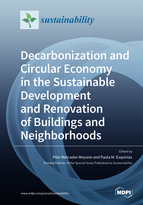Decarbonization and Circular Economy in the Sustainable Development and Renovation of Buildings and Neighborhoods
A special issue of Sustainability (ISSN 2071-1050).
Deadline for manuscript submissions: closed (31 July 2020) | Viewed by 51090
Special Issue Editors
Interests: artificial intelligence and sustainability; sustainable renovation of buildings; neighborhood regeneration; circular economy; decarbonization of the construction sector; sustainable construction; eco-efficient constructive solutions; resource efficiency in architecture, engineering, and urbanism
Special Issues, Collections and Topics in MDPI journals
Interests: sustainable renovation of buildings; neighborhood regeneration; circular economy; decarbonization of construction sector; sustainable construction; eco-efficient constructive solutions; resource efficiency in architecture; engineering and urbanism
Special Issue Information
Dear Colleagues,
In recent years, the building sector has been turning towards intervening in the existing city building stock. In fact, it is generally accepted that the refurbishment of buildings and urban regeneration based on sustainability must form the axis of reformulation of the building sector. At present, achieving sustainable urban development inevitably involves improving existing buildings, thereby preventing the need for city growth, and for the emptying of established neighborhoods. Furthermore, considering the whole life cycle, the great amount of greenhouse emissions derived from the construction sector is well known; thus, in order to reach a decarbonized society, it is important to provide eco-efficient construction materials and solutions, adding the principles of the circular economy and resource efficiency.
Therefore, the theme of this Special Issue is the “Decarbonization and Circular Economy in the Sustainable Development and Renovation of Buildings and Neighborhoods” in response to the objectives not only raised in the Horizon 2020 but by all the people who seek a more sustainable world. This Special Issue of Sustainability focuses on, but is not limited to:
- Obtaining an overview of the environmental problems that arise from construction activity, focusing on refurbishment as an alternative to the current crisis in the construction sector, as well as on actions designed to minimize environmental effects on the environment;
- Searching for new alternatives to conventional construction solutions that minimize the environmental impact of the construction activity, improve indoor environmental quality of buildings, build or refurbish, always from a rentable and optimal cost in time, and implement a circular economy and an efficient resource and waste management;
- Minimizing the consumption of material resources, energy consumption and CO2 emissions in construction and looking for the proper management of construction and demolition waste and the opportunities for their recycling and reuse;
- Sustainable planning and urban development, for an ordered and sustainable growth.
Prof. Dr. Pilar Mercader-Moyano
Dr. Paula M. Esquivias
Guest Editors
Manuscript Submission Information
Manuscripts should be submitted online at www.mdpi.com by registering and logging in to this website. Once you are registered, click here to go to the submission form. Manuscripts can be submitted until the deadline. All submissions that pass pre-check are peer-reviewed. Accepted papers will be published continuously in the journal (as soon as accepted) and will be listed together on the special issue website. Research articles, review articles as well as short communications are invited. For planned papers, a title and short abstract (about 100 words) can be sent to the Editorial Office for announcement on this website.
Submitted manuscripts should not have been published previously, nor be under consideration for publication elsewhere (except conference proceedings papers). All manuscripts are thoroughly refereed through a single-blind peer-review process. A guide for authors and other relevant information for submission of manuscripts is available on the Instructions for Authors page. Sustainability is an international peer-reviewed open access semimonthly journal published by MDPI.
Please visit the Instructions for Authors page before submitting a manuscript. The Article Processing Charge (APC) for publication in this open access journal is 2400 CHF (Swiss Francs). Submitted papers should be well formatted and use good English. Authors may use MDPI's English editing service prior to publication or during author revisions.
Keywords
- circular economy
- decarbonization of construction sector
- refurbishment of buildings
- neighborhood regeneration
- eco-efficient construction solutions
- construction and waste management
- indoor environmental quality
- resource efficiency







